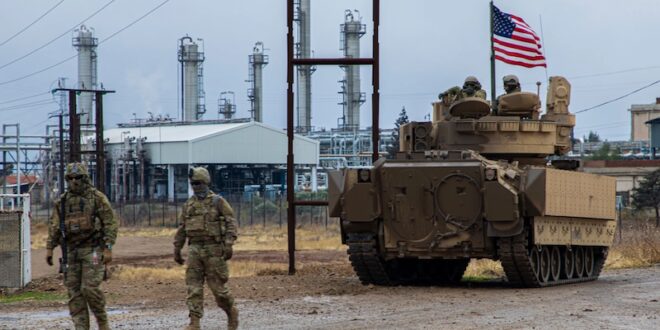When the US led an international coalition in mid-2014 to bomb Daesh targets in Syria and Iraq, the terrorist organization had already occupied large swathes of territory spanning the two Arab countries and had the means to send its fighters all the way to Baghdad.
A dozen nations carried out coordinated bombing raids but the US was the only country to establish ground bases in war-torn Syria. Allying itself with the Syrian Kurds, fighting under the umbrella of the Syrian Democratic Forces, or SDF, it extended its presence in oil-rich eastern Syria where it remains today.
The alliance with the SDF was instrumental in destroying most of Daesh’s fighting power in this vast and highly strategic region, at a time when the Assad regime was fighting for its life against rebel groups in the south and northwest.
At present there are thousands of Daesh detainees in SDF detention centers with their families living in scattered camps. Their fate — the majority of them foreign nationals — is unlikely to be resolved anytime soon since most Western countries refuse to have them back.
But while the main reason for the US military presence in eastern Syria, which is the fight against Daesh, has become less of a priority, despite the fact that remnants of the terror group remain active in the remote areas between Syria and Iraq, Washington’s objectives appear to have shifted.
In 2015, Russia intervened militarily in Syria to save the Assad regime, a mission which, despite its ruthlessness and high civilian casualties, succeeded. Most of the armed rebel groups have been crushed and those who surrendered were moved to the rebel-controlled Idlib province in the northwest.
Also coming to the regime’s aid were thousands of Iran-backed fighters belonging to Shiite militias, which were active in Iraq, Lebanon and Afghanistan. Syria had become a magnet for foreign fighters with conflicting agendas.
With pro-Iran militias claiming victory over Daesh in Iraq, the US saw its sway over a country it had invaded and plundered a decade before quickly being replaced by its rival, Iran. Tehran’s hardliners saw an opportunity to extend their influence through Baghdad to Damascus and all the way to Beirut. A geopolitical tug-of-war was unleashed.
To truncate such a plan, the US buffered up its military garrison at the crucially situated Al-Tanf, overlooking the confluence of the borders of Syria, Jordan and Iraq. According to published figures, there are at least 900 active US troops in eastern Syria, in addition to an undisclosed number of contractors.
Making things more complicated, Turkiye, which supported the anti-regime Syrian Free Army as early as 2011, decided to send its troops into northern Syria in 2016 to fight the Syrian Kurdish People’s Protection Units, or YPG, which is associated with the SDF. Ankara claims that the YPG is in cahoots with the Kurdistan Workers’ Party, or PKK, which it considers a terrorist organization.
Plans by Turkish President Recep Tayyip Erdogan to send his army into northern Syrian territory to crush the Kurds were foiled by the Americans. With Erdogan and Vladimir Putin working together on Syria, the geopolitical game had become even more precarious for all.
Syria and Russia had dubbed the US occupation of eastern Syria illegal and had called for its immediate end. Damascus accused the Americans of stealing Syrian oil, which in reality is happening. President Donald Trump ordered a sudden withdrawal of his troops in 2019 but Turkiye’s decision to launch a major military operation there forced the White House to suspend the pullback.
The presence of US troops in northeastern Syria amid heightening tensions between Washington and Tehran, the face-off between the West and Russia in Ukraine, and the recent political rehabilitation of the Assad regime by the Arab League are raising the stakes in that part of Syria. Iran-backed militias in Iraq have launched a number of drone attacks against US targets there, the most serious of which took place in March.
But now, according to a leaked US intelligence report, Russia, Syria and Iran have adopted a plan to drive American troops out by launching attacks against American assets in the region through a proxy war involving local tribes and militias.
And last week the US acknowledged reports that it has deployed its High Mobility Artillery Rocket System, or HIMARS, in eastern Syria — and not for the first time. The highly advanced system was sent to southern Syria, from Jordan, in 2017, according to CNN. But the Pentagon denied Turkish media reports that the launchers had been transferred to the SDF in northern Syria, adding that they were in the area for “force protection.”
Initially, the deployment of the HIMARS system was a response to movements by pro-regime forces, who had been deploying their own artillery near the perimeter of the 55 km “de-confliction zone” surrounding Al-Tanf.
But now analysts believe that the recent deployment is a US reaction to intelligence reports that Iranian drones may be used more extensively against American targets in the area. As to immediate US objectives, there are concerns about the increasing influence of Russia and Iran in the region, and some in the Pentagon believe that maintaining a US presence in Syria is important for keeping these countries in check.
The US continues to reject any contact with the Assad regime and does not support efforts to normalize ties with Damascus, based on the step-by-step approach in the absence of a political settlement and accountability. Still, its military presence in parts of Syria is becoming a liability and difficult to defend.
Making things more difficult is the fact that Syria’s opposition is now showing signs that it is ready to negotiate directly with Damascus under UN auspices. Syria’s Kurds, too, may soon wish to resume talks with Damascus about an autonomy deal. Even a feeble restart of talks will boost Assad’s legitimacy and make the US presence in Syria an awkward one.
 Eurasia Press & News
Eurasia Press & News


